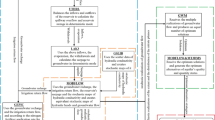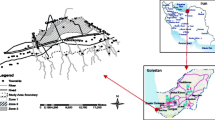Abstract
In decision-making processes, reliability and risk aversion play a decisive role. The aim of this study is to perform an uncertainty assessment of the effects of future scenarios of sustainable groundwater pumping strategies on the quantitative and chemical status of an aquifer. The good status of the aquifer is defined according to the terms established by the EU Water Framework Directive (WFD). A decision support systems (DSS) is presented, which makes use of a stochastic inverse model (GC method) and geostatistical approaches to calibrate equally likely realizations of hydraulic conductivity (K) fields for a particular case study. These K fields are conditional to available field data, including hard and soft information. Then, different future scenarios of groundwater pumping strategies are generated, based on historical information and WFD standards, and simulated for each one of the equally likely K fields. The future scenarios lead to different environmental impacts and levels of socioeconomic development of the region and, hence, to a different degree of acceptance among stakeholders. We have identified the different stakeholders implied in the decision-making process, the objectives pursued and the alternative actions that should be considered by stakeholders in a public participation project (PPP). The MonteCarlo simulation provides a highly effective way for uncertainty assessment and allows presenting the results in a simple and understandable way even for non-experts stakeholders. The methodology has been successfully applied to a real case study and lays the foundations to perform a PPP and stakeholders’ involvement in a decision-making process as required by the WFD. The results of the methodology can help the decision-making process to come up with the best policies and regulations for a groundwater system under uncertainty in groundwater parameters and management strategies and involving stakeholders with conflicting interests.


Similar content being viewed by others
References
Arhonditsis GB, Perhar G, Zhang W, Massos E, Shi M, Das A (2008) Addressing equifinality and uncertainty in eutrophication models. Water Resour Res 44:W01420. doi:10.1029/2007WR005862
Capilla JE, Llopis-Albert C (2009) Gradual conditioning of non-gaussian transmissivity fields to flow and mass transport data. J Hydrol 371:66–74. doi:10.1016/j.jhydrol.2009.03.015
CHJ (Júcar Water Agency) (2016) Júcar river basin authority. http://www.chj.es/
CHS (Segura Water Agency) (2016) Segura river basin authority. http://www.chsegura.es/
Custodio E (2002) Aquifer overexploitation: what does it mean? Hydrogeol J 10:254–277
EC (2000). Directive 2000/60/EC of the European Parliament and of the Council of October 23 2000, establishing a framework for community action in the field of water policy. Official Journal of the European Communities L327/1eL327/72. 22.12.2000
EC (2006) Directive 2006/118/EC of the European Parliament and of the Council of 12 December 2006 on the protection of groundwater against pollution and deterioration
Gómez-Hernández JJ, Srivastava RM (1990) ISIM3D: an ANSI-C three dimensional multiple indicator conditional simulation program. Comput Geosci 16(4):395–440
Harbaugh AW, Banta ER, Hill MC and McDonald MG (2000) MODFLOW- 2000, The US geological survey modular groundwater model-user guide to modularization concepts and the groundwater flow process. US Geol. Surv. Open-File Rep 00–92, 12
Hu LY (2000) Gradual deformation and iterative calibration of Gaussian related stochastic models. Math Geol 32(1):87–108
Jagelke J, Barthel R (2005) Conceptualization and implementation of a regional groundwater model for the Neckar catchment in the framework of an integrated regional model. Adv Geosci 5:105–111
Llopis-Albert C (2008) Stochastic inverse modeling conditional to flow, mass transport and secondary information. Universitat Politècnica de València, València. ISBN 978-84-691-9796-7
Llopis-Albert C, Capilla JE (2009a) Gradual conditioning of non-gaussian transmissivity fields to flow and mass transport data. Demonstration on a synthetic aquifer. J Hydrol 371:53–55. doi:10.1016/j.jhydrol.2009.03.014
Llopis-Albert C, Capilla JE (2009b) Gradual conditioning of non-gaussian transmissivity fields to flow and mass transport data. Application to the macrodispersion experiment (MADE-2) site, on Columbus air force base in Mississippi (USA). J Hydrol 371:75–84. doi:10.1016/j.jhydrol.2009.03.016
Llopis-Albert C, Capilla JE (2010a) Stochastic simulation of non-gaussian 3D conductivity fields in a fractured medium with multiple statistical populations: a case study. J Hydrol Eng 15(7):554–566. doi:10.1061/(ASCE)HE.1943-5584.0000214
Llopis-Albert C, Capilla JE (2010b) Stochastic inverse modeling of hydraulic conductivity fields taking into account independent stochastic structures: a 3D case study. J Hydrol 391:277–288. doi:10.1016/j.jhydrol.2010.07.028
Llopis-Albert C, Pulido-Velazquez D (2014) Discussion about the validity of sharp-interface models to deal with seawater intrusion in coastal aquifers. Hydrol Process 28(10):3642–3654
Llopis-Albert C, Pulido-Velazquez D (2015) Using MODFLOW code to approach transient hydraulic head with a sharp-interface solution. Hydrol Process 29(8):2052–2064. doi:10.1002/hyp.10354
Llopis-Albert C, Palacios-Marqués D, Merigó JM (2014) A coupled stochastic inverse-management framework for dealing with nonpoint agriculture pollution under groundwater parameter uncertainty. J Hydrol 511:10–16. doi:10.1016/j.jhydrol.2014.01.021
Llopis-Albert C, Merigó JM, Palacios-Marqués D (2015) Structure adaptation in stochastic inverse methods for integrating information. Water Resour Manage 29(1):95–107. doi:10.1007/s11269-014-0829-2
Llopis-Albert C, Merigó JM, Xu Y (2016) A coupled stochastic inverse/sharp interface seawater intrusion approach for coastal aquifers under groundwater parameter uncertainty. J Hydrol 540:774–783. doi:10.1016/j.jhydrol.2016.06.065
McDonald MG and Harbaugh AW (1988) A modular three-dimensional finite-difference groundwater flow model. US geological survey technical manual of water resources investigation, Book 6, US geological survey, Reston, Virginia, 586
Molina JL, Pulido-Velazquez M, Llopis-Albert C, Peña-Haro S (2013) Stochastic hydro-economic model for groundwater quality management using Bayesian networks. Water Sci Technol 67(3):579–586. doi:10.2166/wst.2012.598
Peña-Haro S, Llopis-Albert C, Pulido-Velazquez M (2010) Fertilizer standards for controlling groundwater nitrate pollution from agriculture: El Salobral-Los Llanos case study, Spain. J Hydrol 392:174–187. doi:10.1016/j.jhydrol.2010.08.006
Peña-Haro S, Pulido-Velazquez M, Llopis-Albert C (2011) Stochastic hydro-economic modeling for optimal management of agricultural groundwater nitrate pollution under hydraulic conductivity uncertainty. Environ Model Softw 26(8):999–1008. doi:10.1016/j.envsoft.2011.02.010
Pulido-Velazquez D, Llopis-Albert C, Peña-Haro S, Pulido-Velazquez M (2011) Efficient conceptual model for simulating the effect of aquifer heterogeneity on natural groundwater discharge to rivers. Adv Water Resour 34(11):1377–1389. doi:10.1016/j.advwatres.2011.07.010
Reichert P, Borsuk M, Hostmann M, Schweizer S, Spörri C, Tockner K, Truffer B (2005) Concepts of decision support for river rehabilitation. Environ Model Softw 22:188–201
Wright SAL, Fritsch O (2011) Operationalising active involvement in the EU water framework directive: why, when and how? Ecol Econ 70(12):2268–2274
Zhou H, Gómez-Hernández JJ, Li L (2014) Inverse methods in hydrogeology: evolution and recent trends. Adv Water Resour 63:22–37. doi:10.1016/j.advwatres.2013.10.014
Author information
Authors and Affiliations
Corresponding author
Rights and permissions
About this article
Cite this article
Llopis-Albert, C., Palacios-Marqués, D. & Merigó, J.M. Decision making under uncertainty in environmental projects using mathematical simulation modeling. Environ Earth Sci 75, 1320 (2016). https://doi.org/10.1007/s12665-016-6135-y
Received:
Accepted:
Published:
DOI: https://doi.org/10.1007/s12665-016-6135-y




